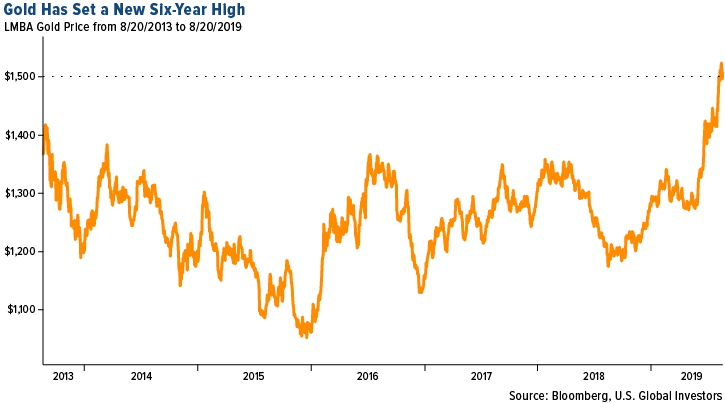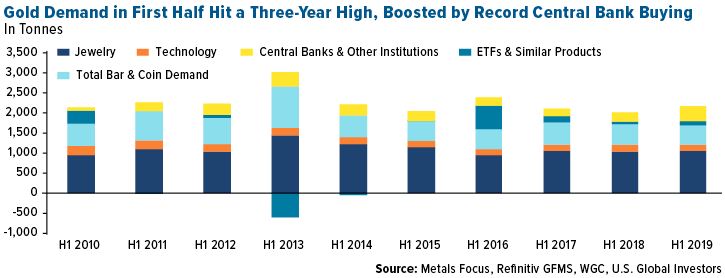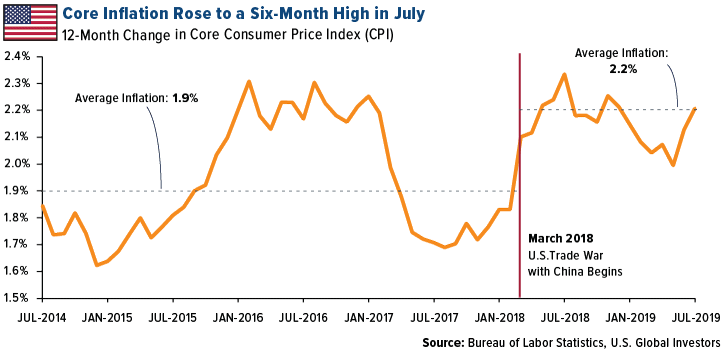
Gold has been on a tear so far this year. The yellow metal crossed above $1,400 per ounce in June then hit a six-year high of above $1,500 just weeks later. As of August 20 gold was trading at $1,507. In fact, gold is not far off from the stock market’s gains so far this year. As of August 20 the S&P 500 returned 18 percent year-to-date with gold just behind at a return of 17.25 percent.
Analysts at Goldman Sachs now say that $1,500 is only the beginning, and that we could see $1,600-an-ounce gold within the next six months.
The yellow metal isn’t just doing well in U.S. dollar terms. It hit all-time highs in multiple currencies including the Australian dollar, South African rand and Canadian dollar.

Gold Demand Keeps Growing
Gold ETFs attracted $2.6 billion of net global inflows in July, raising their collective holdings to 2,600 tonnes—a level unseen since March 2013, according to the World Gold Council (WGC).
“If growth worries persist, possibly due to a trade war escalation, gold could go even higher, driven by a larger ETF gold allocation from portfolio managers who still continue to under-own gold,” Goldman analyst Sabine Schels said in a note to investors. “Gold ETFs have recently built momentum almost as strong as in 2016, and we believe that can be maintained in the short-term.”
As for demand in the first half of this year – it was the best in three years, climbing to 2,181.7 tonnes, largely due to record buying by central banks. Central bank purchases of bullion rose an incredible 47 percent year-over-year in the second quarter, pushing the total amount for the January-to-June period to its highest since central banks became net buyers of gold in 2010. Poland was the top buyer—ahead of Russia, even—with reserves growing 77 percent to 100 tonnes.

Trade War and Negative-Yielding Debt Driving Gold’s Appeal
The ongoing U.S.-China trade war has investors worried and uncertainty remains surrounding a potential resolution. Gold has historically been viewed as a “safe” asset during times of geopolitical tension when currencies or stock markets might suffer big swings. On August 1 when President Donald Trump announced a new round of tariffs on Chinese goods, the stock market fell 0.9 percent on the day. Then on August 13 the administration announced some of those tariffs would be delayed until December to avoid hurting Christmas shopping. The S&P 500 soared.
Should the trade war continue to escalate, it could cost the world economy “dearly,” according to Bloomberg. New modeling by Bloomberg analysts shows that global GDP would be 0.6 percent lower by 2021, amounting to a whopping $1.2 trillion hit, if markets slumped as a result of a full blown trade war.
Another factor driving gold and worrying investors is the growing amount of negative-yielding debt. The total value of negative-yielding debt around the world touched a new record of $15 trillion in August. Plus, the nominal yield of the 10-year Treasury fell below 2 percent.
Inflation Is Starting to Pick Up
More than a year after the start of the U.S.-China trade war, we’re starting to see consumer prices increase. Tariffs are like taxes. Core inflation, which excludes food and energy, rose to a six-month high of 2.2 percent year-over-year in July. In the chart below, you can see that average inflation since the trade war started in March 2018 is higher than it was in the months prior.

As we’ve written about before, inflation has historically been positive for the price of gold as it boosts the metal’s appeal. With inflation on the rise, now might be the time to boost your allocation to gold.
How to Participate in Gold’s Rally
You could own physical good, but a drawback is that is doesn’t yield or produce anything. Another way to get access is through stocks, but it might be difficult to decide which companies to invest in.
We believe one of the best ways to gain exposure to the gold space is with the U.S. Global GO GOLD and Precious Metal Miners ETF (GOAU). The fund provides access to companies engaged in the production of precious metals through active (mining) and passive (owning royalties) means.
Learn more about GOAU and the companies it invests in by clicking here.
All opinions expressed and data provided are subject to change without notice. Some of these opinions may not be appropriate to every investor.
The consumer price index (CPI) is an index of the variation in prices paid by typical consumers for retail goods and other items.
The LBMA Gold Price is the global benchmark price for unallocated gold delivered in London.
The S&P 500 Stock Index is a widely recognized capitalization-weighted index of 500 common stock prices in U.S. companies.
